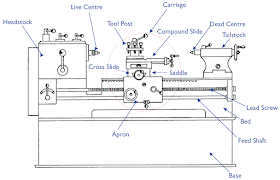Description and function of lathe parts :
1. The Bed
The lathe bed forms the base of the machine. the headstock and tailstock are located at either end of the bed and the carriage rests over the lathe bed and slides over it.
The lathe bed is the main guiding member of the lathe machine so it must satisfy the following condition.
- It should be sufficiently rigid to prevent deflection
- It must be massive with sufficient depth and width to absorb vibration
- It must resist the twisting
- To avoid distortion
For this point of view, the bed material should have high compressive strength, should be wear-resistant and absorb vibration.
Cast iron alloyed with nickel and chromium forms a good material suitable for lathe bed.
2. The Headstock
The headstock is secured permanently on the inner ways at the left-hand end of the lathe bed.
It comprises essentially a hollow spindle and mechanism for driving and altering the spindle speed.
3. The Tailstock
The tailstock is located on the inner ways at the right-hand end of the bed.
This has two main use:
- It supports the other end of the work it holds a tool for performing an operation such as drilling, reaming, tapping etc.
4. Carriage
The carriage of a lathe has several parts that serve to support, move and control the cutting tool.
Parts are following below :
- Saddle
- Cross-slide
- Compound slide
- Toolpost
- Apron
Saddle is an H-shaped casting that fits over the bed and slides along with the ways. It carried the cross-slide and tool post.
The cross-slide comprises a casting, machined on the underside for attachment to the saddle and carries location on the upper face for the tool post or compound rest.
The compound rest is mounted on the top of the cross-slide. It is used for obtaining angular cuts and short tapper.
The tool post located on the top of the compound rest to hold the tool and to enable it to be adjusted to a working position.
Type of tool post :
- Single screw tool post
- Four-bolt tool post
- Open side tool post
- Four-way tool post
The apron is fastened to the saddle and hangs over the front of the bed.
Apron contains gears, clutches, and levers for operating the carriage by hand and power feeds.
5. Feed Mechanism
The movement of the tool relative to the work is termed as "feed".
A lathe tool may have three types of feed :
- Longitudinal
- Cross
- Angular
6. Gear Box
The quick-change gear-box is placed below the headstock and contains a number of different sized gears.
This is the main parts of lathe machine. according to different lathe machine types are available in the market so different types to have different parts are there for various operations on lathe machine with the safety precaution.





